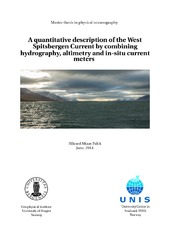A quantitative description of the West Spitsbergen Current by combining hydrography, altimetry and in-situ current meters
Master thesis
Permanent lenke
https://hdl.handle.net/1956/8797Utgivelsesdato
2014-06-02Metadata
Vis full innførselSamlinger
- Geophysical Institute [1195]
Sammendrag
In a warming Arctic Ocean (AO) it is important to study its main source of oceanic heat and salt. Here, seasonal climatological sections of the West Spitsbergen Current (WSC) across 78.83°N have been constructed using hydrographic data from 1956 to 2013. They have proven to replicate the large scale features of the barotropic branch and the eastern baroclinic branch of the WSC. However, the eastern baroclinic branch is not fully resolved in this section as the sections western boundary is too far east. Three anomaly periods within the data set are defined (1956- 2003, 2004- 2007, 2008-2013) and presented in order to study the warm anomaly de- tected in the middle of the 2000s. Surface temperatures exceeding 3<degrees>C in combination with an upward displacement of the Atlantic Water (AW) core were revield in the winter warm anomaly section. A significant in- crease in the buoyancy of the AW was detected during the summer warm anomaly. These two factors may have a significant impact on the sea ice cover in the AO. An approximation of the pressure driven surface velocity vs has been calculated from in-situ current meters (vsc ) and compared to the surface velocity calculated from altimetry (vsa). The latter is found to be too strong with a mean velocity of 0.22ms^{-1} compared to the mean vsc equal to 0.10 m s^{-1}. The horizontal shape of vsa was not comparable to approximations to the barotropic jet of the WSC found in literature. Based on the hydrographic sections, in-situ current meters and altimetry, the summer and the winter volume transports (VT ) was calculated for the eastern baroclinic and the barotropic branch. The volume transport estimated from vsc (VTc) was underestimated (1.2 to 1.8Sv for summer and 0.6 to 1.6 Sv for winter) due to the chosen grid. By extrapolating the geostrophic velocity to the lost data area VTc was nudged upwards in the range of 0.3 to 0.4Sv.The winter VT of AW was found to increase through the three periods with a distinct peak of 4.4 Sv during the second period (2004 to 2007). After the warm anomaly period the mean temperature of the AW was not seen to decrease to pre-anomaly values. For summer the decrease was 0.3<degrees>C from the second to the third period, and for winter the temperature increased further by 0.1<degrees>C. As a consequence of the observed increase in AW mean temperature in combination with the steady volume transport may continue to warm the Arctic.
